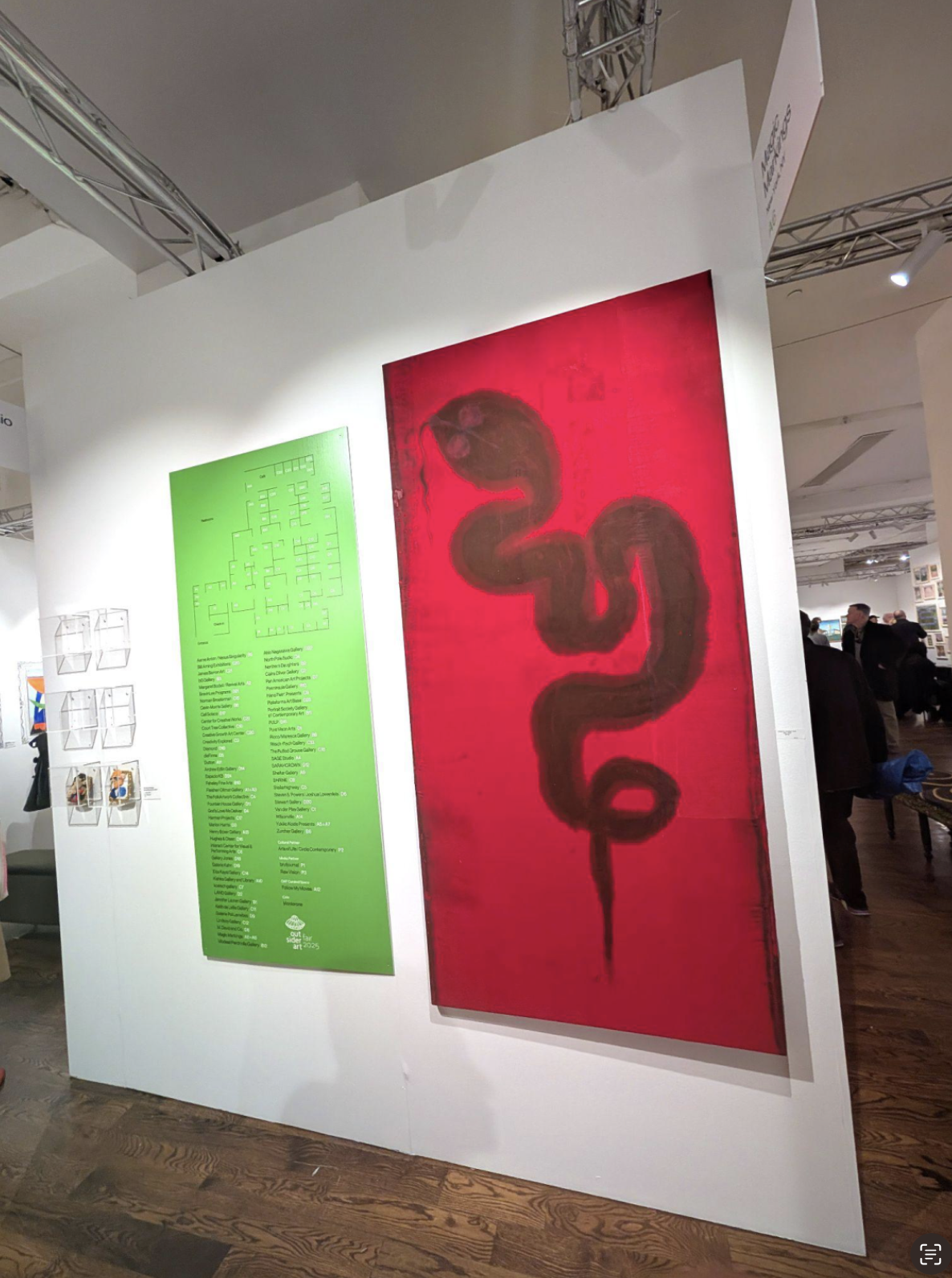OUTSIDER ART FAIR 2025
BETWEEN VISIONARY AND THE MARKETABLE
Published In Two Coats Of Paint
March 12, 2025
Alexandria Deters at Bill Arning Exhibitions
What does “outsider art” mean when the work so labeled is framed in a glossy finish and sold for six figures? When Sanford L. Smith founded the Outsider Art Fair in 1993, he meant it to promote true outsider artists and showcase their work. In 2013, New York art dealer Andrew Edlin bought the fair and it has since become one of New York’s most beloved art events. But it now presents something of a paradox: a space dedicated to self-taught, visionary, and unconventional artists, yet increasingly colonized by prominent galleries and high-end collectors. It used to be that outsider artists were simply those without a place in the art market. Now the term has become a catch-all phrase encompassing all and sundry untrained, visionary, and neurodivergent artists. It covers most working artists I know while failing to describe some of those historically celebrated as outsider artists.
BravinLee Programs: Robert Forman
James Barron Art (CT), Winfred Rembert
It’s worth distinguishing outsider from folk art, as the two are often intertwined. Outsider art is sometimes equated with Art Brut, a term coined by Jean Dubuffet to describe work that is created by self-taught artists and characteristically and rough in execution. This work tends to have an intense, idiosyncratic quality. Traditionally, outsider artists have used unconventional materials or techniques, though over the past 30 years MFA programs have embraced such materials and techniques and thereby eroded the criterion. Folk art is generally tied to cultural traditions, craftsmanship, and generational techniques. Think quilting. Unlike outsider art, folk art skills might be passed down through apprenticeships or oral traditions and can serve both personal storytelling and gallery display. Folk artists may be self-taught, but their work is typically sourced in tradition rather than individual psychological impulse.
At the Outsider Art Fair, a mix of special workspaces, small independent dealers, and established mainstream galleries coexist. This year, the range of prices was glaringly wide. Newer works sold for $300 to $20,000, while those by outsider and folk icons like Bill Traylor and Winfred Rembert commanded $180,000 to $300,000. Today’s outsider art reiterates the same tropes. Like an ouroboros, the snake eating its own tail, outsider art is no longer siloed in isolation and devours its own imagery. Speaking of serpents, upon entering the fair, I challenged my eight-year-old to find his favorite snake painting. My wife looked at me like I was an idiot, but shortly after stepping inside, we were surrounded by a panoply of pythons.
Other visual motifs recur persistently: crude figuration, toothy smiles, cats (a personal favorite), neurotic and hyper-focused mark-making, minuscule realism. Fiber works have become a trope. Ray Masterson’s embroideries at the Andrew Edlin (NYC) space were standouts. Masterson began these works, each the size of a large postage stamp, while serving time in a Connecticut prison, stitching them from fibers he repurposed from socks and clothing. The mystery of how he procured a needle only adds to the intrigue. A few booths away at BravinLee Programs (NYC), Robert Forman’s cityscapes played tricks on the eye. Appearing as intricate paintings from afar, embroideries up close, the works were actually glued thread on board, a technique the artist honed through studying with the Huichol in Mexico. Contrasting with Forman’s meticulous craft was the art brut embroidery of Alexandria Deters at Bill Arning Exhibitions (upstate NY). Her psychologically intense works blend humor with devotion and activism.
Quilted works peppered the fair, with Sharon Kerry-Harlan’s large quilt at Claire Oliver Gallery (NYC) especially notable. Threading past to present, memory to material, Kerry-Harlan’s petroglyphs and deities dance on the fabric. The work resembles Rashid Johnson’s Tell It on the Mountain, where branding in red hardwood evokes historical memory. In a brief conversation, Johnson – a contemporary art star and certainly not an outsider – said he was unaware of Kerry-Harlan’s quilts. But the contrast between his placement in the Guggenheim and her classification as “folk art” presses my question of just what it means to be an outsider.
Claire Oliver Gallery (NYC): Sharon Kerry-Harlan
Kishka Gallery and Library (VT): June Gutman
While the fair put a premium on unconventional materials, with fiber works and works on paper dominating, very good traditional paintings were also on display. Pulp Gallery (Holyoke, MA) exhibited Sarah Lee’s intimate small works. One particularly surreal one evokes Gertrude Abercrombie at her best, depicting a woman in a bathtub filled with rice pudding, surrounded by pigeons. Billy White’s paintings, shown by Shrine Gallery (NYC), explode with primary colors, championing the Brute art style. Meanwhile, muted pastel colors ruled Kishaka Gallery and Library (Vermont) by way of June Gutman, a Jewish artist from Montreal who channels anxious terror, psychedelia, and mystical transcendentalism. Peninsula Gallery (NYC) presented Adhemar Ahmad – an East Harlem-based artist, street-side bookseller, and avid chess player – as a true outsider. My favorite painting of his: a simple black cat that echoes Bill Traylor’s aesthetic while radiating an iconically chess-like vibe.
Judging by the Outsider Art Fair 2025, outsider art, at least in its marketable form, is no longer the exclusive province of purely raw, unfiltered, untrained artists creating work outside the art market. In the Internet Age, where every story has its 15 minutes and niches are called fandoms, galleries, collectors, and critics have recontextualized outsider art as part of the broader art world. This has relaxed the tension, though it was still evident at the fair, between art’s authenticity and its commodification.
Outsider Art Fair 2025, Metropolitan Pavilion, 125 West 18th Street, New York, NY. February 27–March 2, 2025.
About the author: Jac Lahav (he/them) is a Persian Polish artist, curator, and author, born in Jerusalem and raised in the United States. They graduated with an MFA from Brooklyn College, where they studied with Vito Acconci.











